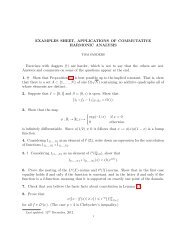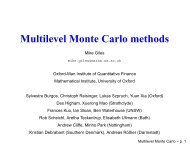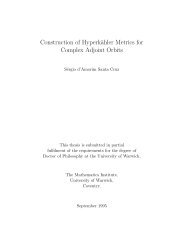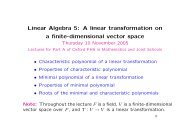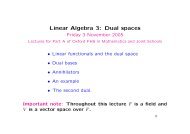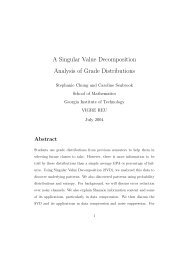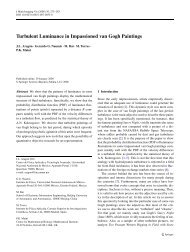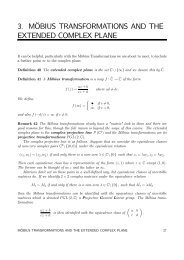Fourier Series and Partial Differential Equations Lecture Notes
Fourier Series and Partial Differential Equations Lecture Notes
Fourier Series and Partial Differential Equations Lecture Notes
Create successful ePaper yourself
Turn your PDF publications into a flip-book with our unique Google optimized e-Paper software.
Chapter 3<br />
The heat equation<br />
In this chapter we shall look at the heat equation in one space dimension, learning a<br />
method for its derivation, <strong>and</strong> some techniques for solving.<br />
3.1 Derivation in one space dimension<br />
A straight rigid metal rod lies along the x-axis. The lateral surface is insulated to prevent<br />
heat loss.<br />
Figure 5<br />
Letρbethemass density perunitlength, cbethe specificheat, T(x,t) bethetemperature<br />
<strong>and</strong>:<br />
• +q(x,t) be the heat flux from − to +;<br />
• −q(x,t) be the heat flux from + to −.<br />
Consider any interval [a,a+h]:<br />
internal energy =<br />
a+h<br />
ρcT(x,t)dx; (3.1)<br />
net heat flux out of [a,a+h] = q(a+h,t)−q(a,t). (3.2)<br />
By conservation of energy, for every interval [a,a+h],<br />
i.e.<br />
Hence, by Leibniz,<br />
rate of change of internal energy+net heat flux out = 0. (3.3)<br />
1<br />
h<br />
d<br />
dt<br />
a<br />
a+h<br />
ρcT(x,t)dx+[q(a+h,t)−q(a,t)] = 0. (3.4)<br />
a<br />
a+h<br />
a<br />
ρc ∂T<br />
∂t (x,t)dx+<br />
<br />
q(a+h,t)−q(a,t)<br />
= 0, (3.5)<br />
h<br />
25




